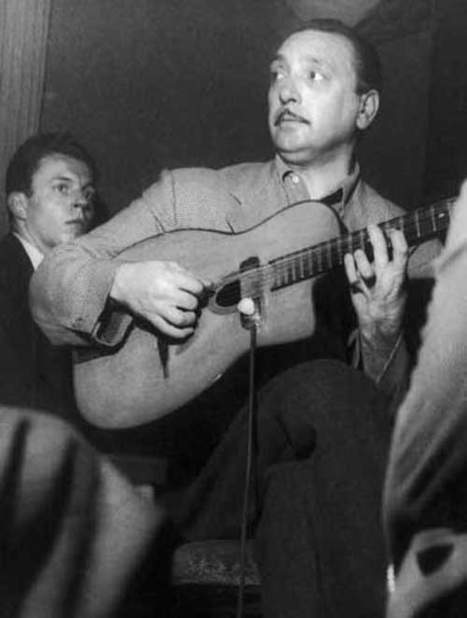He was one of the most extraordinary individuals in jazz history, a largely illiterate gypsy who also happened to be one of the greatest jazz guitarists of all time. He was the first major European jazz musician, the main soloist in an unusual acoustic string group during the 1930s, and a musician whose legacy and influence decades after his death resulted in a major musical movement in Europe.
Early Years
Django Reinhardt was born as Jean Baptiste Reinhardt on January 23, 1910 in Liberchies, Belgium. He grew up as part of a family of Romani gypsies and was given the lifelong nickname of Django which means “I awake.” Some of the members of his family were amateur musicians.
Django started playing the violin before switching to banjo, occasionally doubling on guitar. He began his career playing the French music of the era, making his first recordings as a banjoist in 1928 on ten selections with small groups led by accordionists Jean Vaissade and V. Marceau.

A disaster permanently affected his life and career. One night, Reinhardt accidentally knocked over a candle in his caravan, causing his wife’s artificial flowers to immediately catch on fire. Django was severely burned on his left hand and right leg. While his doctors debated over whether to amputate his hand and leg, a couple of Reinhardt’s friends snuck him out of the hospital. Django underwent a long period of recuperation at home.
It took him a year to be able to walk but he would never be able to use the fourth and fifth fingers of his left hand (which he used to voice chords) ever again. His musical career seemed to be over soon right after it had begun. But by working hard for two years, Reinhardt relearned how to play the guitar. He devised new ways to state chords with just three fingers, and he decided to play jazz after he heard Louis Armstrong’s recording of “Dallas Blues”.
Forging Ahead
There were few jazz guitarists to use as role models. The acoustic guitar, which was replacing the banjo, was often close to inaudible on records except in small combos. Eddie Lang was the pacesetter but even he appeared on many recordings where his role was minor and he was restricted to playing his sophisticated chords behind singers and soloists. Django would have to forge his own musical path.
Other than three songs in 1931 on a date led by Louis Vola (usually a bassist but heard on that occasion on accordion), Django did not record again until 1933. He met violinist Stephane Grappelli in 1931 and, although coming from very different backgrounds (Grappelli was well educated), they enjoyed playing off of each other at jam sessions.
During 1933-34, Reinhardt began to appear regularly on records as a sideman including with singers Eliane DeCreus, Germaine Sablon, and Jean Sablon, studio orchestras, and ensembles led by altoist Andre Ekyan and violinist Michel Warlop. In August 1934 he emerged for the first time as a major soloist on three songs (including “Tiger Rag” and “After You’ve Gone”) while accompanied by his brother guitarist Joseph Reinhardt and bassist Juan Fernandez.
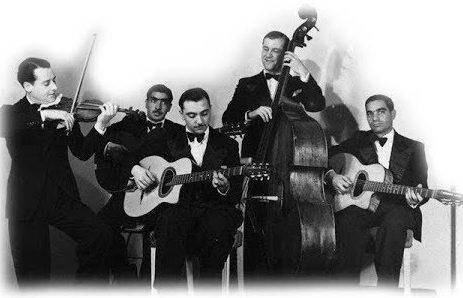
The Hot Club of France
In the summer of 1934, the Hot Club of France invited Reinhardt and Grappelli to put together and perform with a jazz string group. They organized a unit that, in addition to themselves, also had two acoustic rhythm guitars and a bassist. The band was a sensation from the start and the Quintet of the Hot Club of France was born.
Nothing like this had ever been heard before, not in France, the United States, or anywhere in the jazz world. The solos of Reinhardt and Grappelli (who ranked with Joe Venuti and Stuff Smith among jazz violinists), the steady timekeeping of the other musicians, and the interplay between the two lead voices were consistently exciting. Although there had been a few talented European jazz musicians previously, Reinhardt and Grappelli were the first to be innovators.
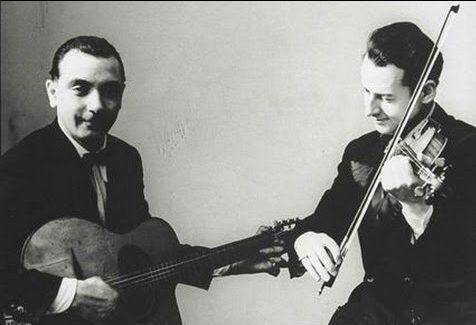
First Recordings
In September 1934, under the title of “Delaunay’s Jazz,” the string group made its earliest recording, cutting “Confessin’” and a vocal feature for Bert Marshall on “I Saw Stars”.
On the sessions of Dec. 28, 1934 with “Dinah”, “Tiger Rag”, “Lady Be Good” and a remake of “I Saw Stars” (this time as an instrumental), the Quintet of the Hot Club of France debuted under that name.
During 1934-39, the group was very busy. The American jazz world took note but, since the quintet never visited the US, its biggest influence was on other new “Hot Club” groups that popped up in Europe. Argentinian guitarist Oscar Aleman, who was actually born a year before Django and spent time in Europe in the 1930s, sounded just like Reinhardt.
In addition to recording swing standards, the Quintet of the Hot Club of France recorded such originals by Reinhardt and Grappelli as “Djangology”, “Tears”, “Daphne”, “Minor Swing”, “Bolero”, “Mabel”, “Naguine”, and “Swing 39.”
Reinhardt remained in demand to accompany French singers on records including Jean Sablon, Germaine Sablon, Le Petit Mirisha, Leo Monosson, Pierre Lord, Nane Cholet, Nina Rette, Bruce Boyce, Yvonne Louis, Jean Trachant, and Jacotte Perrier. The recordings of those vocalists are mostly of interest today due to the guitarist’s playing rather than the singing.
Influence
Whenever major American jazzmen visited Europe, they sought out Django since his solos were on the level of the top trumpeters and saxophonists. Coleman Hawkins, Benny Carter, Barney Bigard, Rex Stewart, Bill Coleman, Arthur Briggs, Dicky Wells, Eddie South, harmonica great Larry Adler and pianist Garnet Clark all recorded with the guitarist while Louis Armstrong met and jammed with him.
In addition, there were hot combo dates led by such fine European musicians as trumpeter Phillipe Brun, tenor-saxophonist Alix Combelle, altoist Andre Ekyan, saxophonist-trumpeter Big Boy Goudie and violinist Michel Warlop, and intimate sessions under the names of Reinhardt and Grappelli that ranged from Grappelli’s Hot Four to unaccompanied guitar solos.
War Years
Those glory years ended with the start of World War II. The Quintet of the Hot Club of France, which was in London, had recorded on August 25, 1939 but, soon after Germany invaded Poland on September 1, Reinhardt impulsively decided to return to Paris while Grappelli stayed in England. Django’s activities during the next five years would make for a great movie by itself.
Somehow he not only survived the Nazi occupation but recorded and performed frequently while managing to avoid being imprisoned or used by the Nazis for propaganda purposes. He utilized his reputation for being unreliable to his advantage, disappearing at various times. While the Nazis thought it would be useful having Django as one of the symbols of France being active, they actually got very little mileage from his presence.
Reinhardt led a new Quintet of the Hot Club Of France that often featured clarinetist Hubert Rostaing in Grappelli’s place. He became one of the first guitarists to lead a big band on record sessions and was also well featured with smaller swing combos led by Brun, Combelle, Briggs, Ekyan, trumpeter Pierre Allier, clarinetist Christian Wagner, and tenor-saxophonist Noel Chiboust. Among his new compositions were “Swing 41”, “Swing 42”, “Dinette”, “Nympheas”, “Feerie”, “Manoir de Mes Reves”, “Belleville”, and his best-known original, “Nuages.”
 Post War Hurdles
Post War Hurdles
After the recording session of July 7, 1943, the records stopped for over a year. Since nothing much had been heard of Django Reinhardt outside of the occupied countries, it was international news after the liberation of France in 1944 when he re-emerged and was found to be in great shape. Django returned to records, even recording with an all-star group taken out of Glenn Miller’s band and appearing on the radio. On January 31, 1946 he had a joyous recorded reunion with Stephane Grappelli and, although they did not choose to perform regularly together, it looked as if Django would continue as he had in the 1930s.
However there were two hurdles to overcome: the electric guitar and bebop. The late Charlie Christian with Benny Goodman during 1939-41 had not only helped to make the electric guitar popular but had developed an entirely new language for the guitar. Christian’s style became the most influential force on other jazz guitarists for the next 25 years around the world. In contrast, few American guitarists outside of Les Paul showed the influence of Django, who would continue in his own individual way.
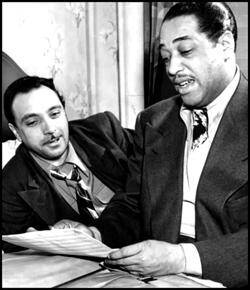
Visit to the United States
In 1946, Reinhardt made his only visit to the United States, touring as a guest with the Duke Ellington Orchestra. Unfortunately Ellington did not write any special music for the guitarist and Django was just featured with Duke’s rhythm section for a few songs each night.
He was disappointed that he was treated by the American jazz public as an unknown rather than as a celebrity, and he was often bored. Django became less reliable as the tour progressed, sometimes showing up late to concerts or choosing to play pool with friends instead. The tour was a disappointment and, other than a surviving broadcast, no recordings resulted.
Bop
Back in France, Django explored both the electric guitar and bebop. While Reinhardt’s solos and his new boppish originals were sometimes rhythmically awkward, as the 1940s progressed he found his own voice in the new music while retaining his trademark sound. He successfully modernized both his playing and his writing with his later compositions including “Babik”, “Swing 48”, and “Moppin’ The Bride”. Unknown to most Americans because most of his recordings were not widely available in the US, by 1949 Django Reinhardt was one of the finest of all bop guitarists, ranking with Tal Farlow and Barney Kessel.
Django seemed poised for further successes. He had several recorded reunions with Grappelli including marathon sessions in Rome during January and February 1949 that resulted in 54 selections. His recordings of 1950-53, which feature him playing bop-oriented music with younger European musicians (including pianist Martial Solal and bassist Pierre Michelot), show that he was continuing to evolve and move ahead. There were plans underway for him to return to the United States as part of Norman Granz’s Jazz At The Philharmonic. One could imagine Reinhardt jamming with Charlie Parker and Dizzy Gillespie and perhaps recording with Oscar Peterson.
Sudden Death
But on May 16, 1953, the 43-year old Django Reinhardt died suddenly from a stroke. And that is where the story normally would have ended. Years passed and, other than in the playing of Les Paul and Charlie Byrd, little of Reinhardt’s style was heard in other guitarists as Charlie Christian’s approach remained dominant. Even Stephane Grappelli mostly played in standard piano quartets. However in 1973, Grappelli was persuaded by guitarist Diz Disley to lead a jazz string group and the response was so favorable that the violinist toured the world in that setting. The comeback of Django Reinhardt’s music had begun.
Renaissance
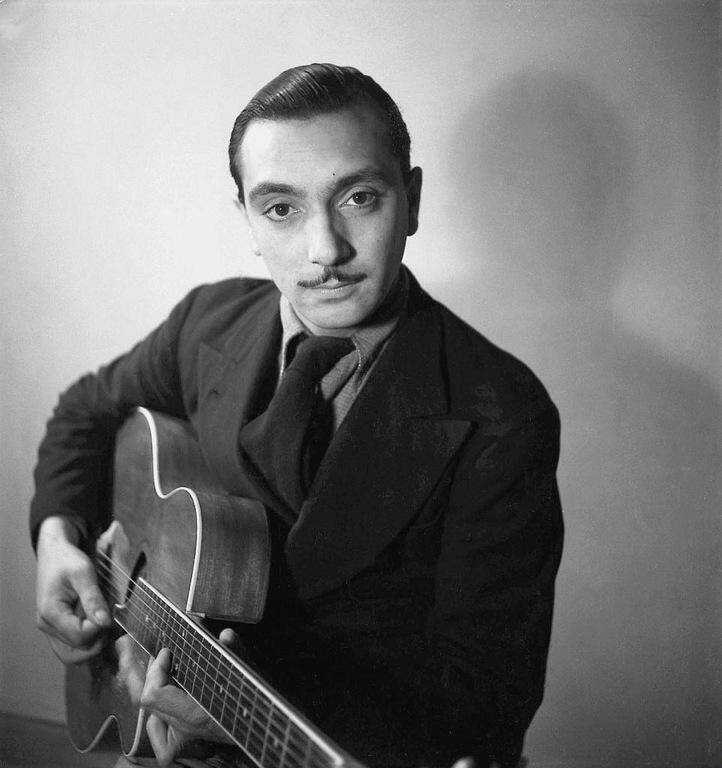 What would eventually be called the “gypsy jazz” movement really took off in the 1980s. Guitarist Jon Larsen founded the Hot Club de Norvege and his Hot Club label has since documented hundreds of swing sessions. A countless number of guitarists (some of whom were actually gypsies) began to emulate Django Reinhardt’s playing, particularly from the 1930s, including Biréli Lagrène (who at the age of 13 sounded like a duplicate of Django), the Rosenberg Trio, and the brilliant Jimmy Rosenberg. The explosion of talent resulted in dozens of “Hot Club” groups being formed and Django Reinhardt festivals becoming very popular. “Gypsy jazz” has become its own musical idiom and a world all its own.
What would eventually be called the “gypsy jazz” movement really took off in the 1980s. Guitarist Jon Larsen founded the Hot Club de Norvege and his Hot Club label has since documented hundreds of swing sessions. A countless number of guitarists (some of whom were actually gypsies) began to emulate Django Reinhardt’s playing, particularly from the 1930s, including Biréli Lagrène (who at the age of 13 sounded like a duplicate of Django), the Rosenberg Trio, and the brilliant Jimmy Rosenberg. The explosion of talent resulted in dozens of “Hot Club” groups being formed and Django Reinhardt festivals becoming very popular. “Gypsy jazz” has become its own musical idiom and a world all its own.
No other jazz musician, decades after his death, has received such a renaissance as Django Reinhardt. But then again, there was only one Django.
Since 1975 Scott Yanow has been a regular reviewer of albums in many jazz styles. He has written for many jazz and arts magazines, including JazzTimes, Jazziz, Down Beat, Cadence, CODA, and the Los Angeles Jazz Scene, and was the jazz editor for Record Review. He has written an in-depth biography on Dizzy Gillespie for AllMusic.com. He has authored 11 books on jazz, over 900 liner notes for CDs and over 20,000 reviews of jazz recordings.
Yanow was a contributor to and co-editor of the third edition of the All Music Guide to Jazz. He continues to write for Downbeat, Jazziz, the Los Angeles Jazz Scene, the Jazz Rag, the New York City Jazz Record and other publications.





